
|   |

|   |
 e-mail: ukb7@rediffmail.com Opulent Odissi Photos courtesy the artistes July 18, 2018 Kolkata, the eastern metropolis, is lucky to be rich in its number of well-groomed Odissi dancers. Thanks to several visits, residency programmes and extended workshops that legendary guru Kelucharan Mohapatra conducted in this part when he was alive, a number of his illustrious disciples today perform and run disciplined centers of training and performance here. Sharmila Biswas and Sutapa Talukdar have been foremost among them and now the young Subikash Mukherjee has joined the rank. Bahana and Ravash were two of the most recent works of the last two choreographers. Vahana (mount) of the traditional deities has been one of the most endearing features of Indian mythology. Indeed, both flora and fauna were associated charmingly with individual gods and goddesses even in the Vedic times when the latter were harbingers of natural forces, and had no specific icons to worship and no temples where their sanctum sanctorum could be seen. Then came the Puranic and Upanishad periods, with clear homomorphic forms, with temples built around the idols to offer sacerdotal and sacramental worship, with mediating priests and with accompanying ritual paraphernalia. How the mounts came to be associated with the pantheon of the gods remains one mystifying feature of the ancient cultic religion, but one sensible surmise has been that they incorporated tribal totems and taboos, and imbibed them in the ritual process in an ongoing process of growth and spread of the Aryan civilisation. Otherwise, with honorable exceptions, there was little to explain why and how owl would be the mount of Lakshmi or rodent that of Ganesha. 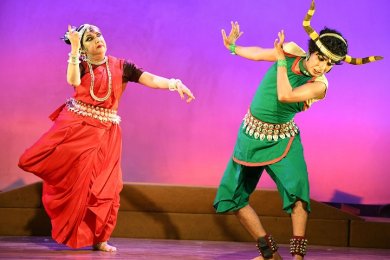 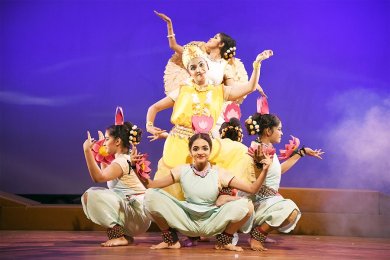
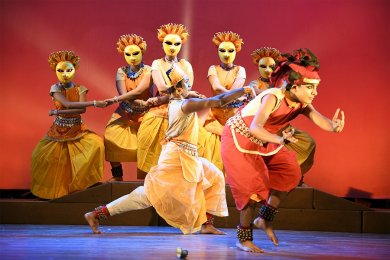
Bahana presented on June 29 by the South Gurukul Society was an innovative recapitulation of this theme, although it steered clear of the anthropological speculations of the above nature. Directed by Sutapa Talukdar, the twelve deities chosen along with their vahanas were Agni - God of fire and his mount the goat; Indra - King of the gods and his mount Airavata the elephant; Pavana - god of the winds and his mount the deer; Yama -the god of death and the underworld, and his mount the buffalo; Surya - the sun god and his mounts the seven stallions. Among the later deities were Mahadeva - the god of destruction and his mount Nandi the bullock; Durga - the mighty demon killer goddess and her mount the lion; Laxmi - the goddess of wealth and her mount the owl; Saraswati - the goddess of learning and her mount the swan; Kartikeya - the god of valorous wars and his mount the peacock; Ganesha - the elephant headed god of benedictions and his mount the rodent; and the Ganga - the mother goddess of salvation and her mount the crocodile. Borrowing extensively from Sanskrit texts as sources and using one's understanding to showcase the glory of the birds and animals that is often left unheeded, Sutapa presented Bahana as inseparable loyal companions to their respective gods and goddesses - - and yet remaining largely unutilized as subjects of classical dance performances against the celebrated representation of their masters throughout the ages - - in her four part repertoire. The mounts were introduced first serving their respective godheads in a colorful choreography (barring the slight aberration that the sun god was driven by a seven stallion chariot and not six). In the second segment, the mounts were paired as twosomes and engaged in humorous repartees with each other, which seemed rather uncalled for. The choreography gathered momentum in the third section and Kelubabu's striking visualisation of chowks and bhramaris, utplavanas and mukhabhinaya were utilized with brilliant impact. The final part was overall tributes and salutations to individual deities. Music by Pt. Subhankar Banerjee was a great strength in the production, adding very well-textured melodies and rhythmic variations and was a class apart. Narration by Barun Chanda was quite well rendered, except that his repeatedly using the expression "mascot" - - that signifies person, animal or thing supposed to bring luck (usually in sporting events) instead of the more apt word "mount" - - jarred somewhat. Script by Saberi Rakshit and Sanghamitra Mukherjee was an asset in its strong Sanskrit scholarship and lyrical resonance. 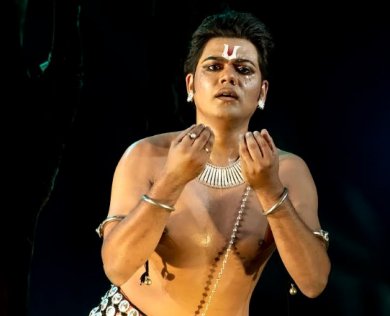 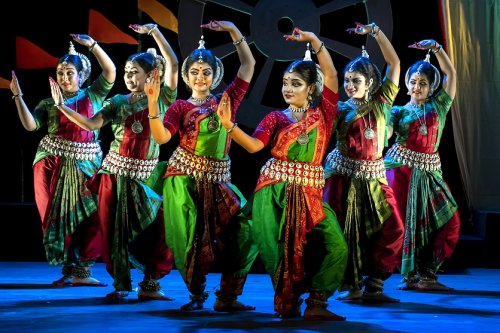 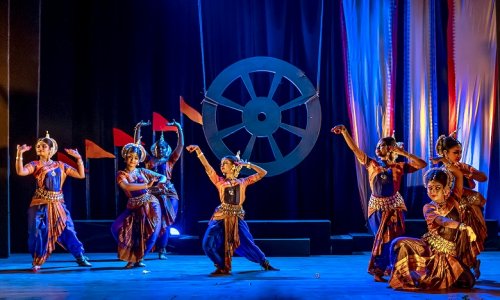 Ravash Ravash presented on July 4 by Sankalpa Nrityan was a variegated affair, celebrating fifteen years of that school of Odissi dance delineating skills of some seventy dancers. Conducted by young Subikash Mukherjee - initially trained by Kelubabu and later groomed under guru Kumkum Mohanty of Odissi Research Centre and guru Ratikant Mohapatra at Srijan - the choreography was marked by several compositions by those stalwarts, expanded suitably to suit the group renderings. All through, the costumes of the dancers were strikingly vivid and caught attention. After the overtures with Ganapati Vandana and Shiva Stuti, the repertoire began with Batu Nitya in raga Mohanam, with composition by Kelubabu and music by Bhubaneswar Misra. Then came another Kelubabu composition of Devi Stuti describing Ardhanariswara. This was followed by a Saraswati Stuti. Then came a series of scintillating Pallavis, in picturesque group compositions and splendid aesthetics. First was a Vasant Pallavi, bearing the stamps of Kelubabu and Bhubaneswar Misra. The second was a Megh Pallavi, in jhampak tala, bearing the handiwork of Ratikant. The third was a Desh Pallavi in ekatali, created by Kumkum Mohanty. The Pallavi trio gave way to a dramatic depiction of Nauka Vihar by Krishna and Radha on the backstage and the forestage taken up by the ecstatic gopis, dancing to Sakhi dekho re..., a composition by Banamali Das. After a group Chandan Yatra, with choreography by Ratikant, there was an elaborate ashtapadi from Gita Govinda, Lalita lavangalata parisheelana komala malaya samire..., with a Kelubabu choreography and music by Bhubaneswar Misra, in ekatali. After a brief intermission came the evening's major solo piece Chudamani Pradan by Subikash himself. Based on Tulsidas's well-known dohas (couplets) and choupais (quartets) from Ram Charit Manas and set to music by the stalwart Raghunath Panigrahi, the solo presentation took wings from the very beginning. Hanumana arriving in Lanka, his wonderment at the grandeur of Ravana's palace, his inability to locate Sita and the eventual delight to find her demure figure in the Ashoka forest were well enacted. Sita's loneliness and lamentation were followed by her sudden shock and surprise to see Hanumana. The latter's brainwave to drop the royal wedding ring of Rama before her brought an instant recognition for Rama's envoy, followed by the earnest mutual dialogue on Sita's and Rama's well-being. After Hanumana gorged some wild berries to quench hunger, Sita gave him the tiara on her head for Rama's recognition and the final leap back of Rama's envoy were all enacted by Subikash with consummate skill and panache. While Subikash followed the choreography of Ratikant - who, in his long career, danced as Hanumana many times and became almost synonymous with his idol - the striking fact was that Subikash was alternately Hanumana and Sita in his Ekaharya Abhinaya. During Ratikant's performance, either Sanjukta Panigrahi or Kumkum Mohanty used to appear as Sita. It was perhaps for the first time in Odishi's history that Subikash attempted Ekaharya Abhinaya for this famous episode, supported by a pleasant backdrop of Ashoka tree and forest to add theatricality. Precisely because of the use of a dramatic set, it becomes then necessary to define the imaginary space for Sita vis-à-vis the space for Hanumana. While this aspect does not bother normal Ekaharya Abhinaya in dance, it would be a good idea to maintain distinction for Sita's and Hanumana's individual dance spaces for enhanced dramatic impact - - when a theatre set is being used - - instead of using the entire stage for each to perform regardless. It is what aesthetics would demand!  Dr. Utpal K Banerjee is a scholar-commentator on performing arts over last four decades. He has authored 23 books on Indian art and culture, and 10 on Tagore studies. He served IGNCA as National Project Director, was a Tagore Research Scholar and is recipient of Padma Shri. Post your comments Please provide your name and email id when you use the Anonymous profile in the blog to post a comment. All appropriate comments posted with name & email id in the blog will also be featured in the site. |